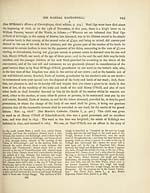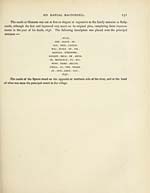Historical account of the Macdonnells of Antrim
(264) Page 250
Download files
Complete book:
Individual page:
Thumbnail gallery: Grid view | List view

25O THE MACDONNELLS OF ANTRIM.
James II., and was mortally wounded at the Boyne. The estate was then finally confiscated, and
sold in 1 701.
Lady Sarah Macdonnell's second husband was sir Charles O'Connor Sligo, who died in 1634.
Of the great family of O'Connor, there were three principal septs, their respective chiefs being
known as O'Connor Don, O'Connor Ruadh, and O'Connor Sligo. Her third husband was Donnell
MacCarthy Mor, prince of his family or race in the province of Munster. In Desmond the
MacCarthys divided into the three great branches, known as the MacCarthy Mor, MacCarthy
Reagh, and MacCarthy Muscraigheach, of Muskerry. See Lodge's Peerage, edited by Archdall, vol.
i., p. 207; Irish Topographical Poems, translated and edited by O'Donovan, introduction, p. [20] ;
Erck's Repertory, Patent Rolls, James I., pp. 72, in.
Lady Catherine Macdonnell married Edward Plunket, of Castlecor, county Meath, esq., in
1639. This gentleman was second son and heir of Patrick Plunket, ninth lord Dunsany, and his
wife Jane, daughter of sir Thomas Heneage, of Haynton, in the county of Lincoln. Patrick lord
Dunsany was forfeited in 1641, but his son Edward received a grant of lands under the act of
settlement. Edward died in May, 1668, leaving three sons by his wife, the lady Catherine Mac-
donnell. Two of these sons, Christopher and Randall, succeeded as tenth and eleventh lords
Dunsany. See Lodge's Peerage, edited by Archdall, vol. vi., pp. 210, 211.
Lady Rose Macdonnell married colonel lord George Gordon, brother of the duke of Suther-
land, who came to Ulster in 1642 as an officer in major-general Monro's army. He assisted the
marquis of Antrim to escape from prison at Carrickfergus, in 1643. This officer is referred to in
Mackay's History of the House and Clan of Mackay, pp. 175, 176, 285, 287, 293 ; see also p. 76,
supra. (115)
The first earl was bound by his grant from the crown to erect a respectable residence in each
of the four manors or baronies comprising his immense estates. Dunluce castle, long previously
built, served for the barony so named, and Clough castle, also a very old structure, amply sufficed
for the barony of Kilconway. In Carey, the earl, then sir Randal, built an elegant and substantial
family residence near the site of the ancient Dunanynie (see pp. 38, 121, supra). The
position of this mansion could not have been more judiciously or tastefully selected. It was com-
paratively sheltered from storms, and yet commanded extensive views of the beautiful and picturesque
scenery on the northern coast. One of the gables of this castle remained until about twenty years
ago, when it was removed by an order from the Court of Chancery, some inhabitants of Ballycastle
having expressed a fear that its fall, sooner or later, might occasion loss of life.
(115) Among Mr. J. F. Campbell's Popular Tales oj still to be familiarly recited among the inhabitants of the
the West Highlands, orally collected, one represents a Scottish district abovenamed. This wild fiction is curious
daughter of the earl of Antrim as being carried off by the as an additional evidence of the close intercourse that
fairies at the time of her birth, and restored again to the formerly existed between the inhabitants on the opposite
family when she had grown up to be a young woman 1 shores of the North Channel. Even their superstitions
This is a good specimen of this class of fairy tales. It is were identical, and the very fairies — the creatures of their
printed as it was taken down word for word, by Hector imagination — are represented as moving to and fro across
Urquhart, in the August of 1S59, when told to him by John the waters of Sruth-na-Maoile, on their own peculiar
Campbell of Strathgairloch. So far as we know, the errands bent. See vol. ii., pp. 97 — 99.
tale has died out on the Antrim coast, although it appears
James II., and was mortally wounded at the Boyne. The estate was then finally confiscated, and
sold in 1 701.
Lady Sarah Macdonnell's second husband was sir Charles O'Connor Sligo, who died in 1634.
Of the great family of O'Connor, there were three principal septs, their respective chiefs being
known as O'Connor Don, O'Connor Ruadh, and O'Connor Sligo. Her third husband was Donnell
MacCarthy Mor, prince of his family or race in the province of Munster. In Desmond the
MacCarthys divided into the three great branches, known as the MacCarthy Mor, MacCarthy
Reagh, and MacCarthy Muscraigheach, of Muskerry. See Lodge's Peerage, edited by Archdall, vol.
i., p. 207; Irish Topographical Poems, translated and edited by O'Donovan, introduction, p. [20] ;
Erck's Repertory, Patent Rolls, James I., pp. 72, in.
Lady Catherine Macdonnell married Edward Plunket, of Castlecor, county Meath, esq., in
1639. This gentleman was second son and heir of Patrick Plunket, ninth lord Dunsany, and his
wife Jane, daughter of sir Thomas Heneage, of Haynton, in the county of Lincoln. Patrick lord
Dunsany was forfeited in 1641, but his son Edward received a grant of lands under the act of
settlement. Edward died in May, 1668, leaving three sons by his wife, the lady Catherine Mac-
donnell. Two of these sons, Christopher and Randall, succeeded as tenth and eleventh lords
Dunsany. See Lodge's Peerage, edited by Archdall, vol. vi., pp. 210, 211.
Lady Rose Macdonnell married colonel lord George Gordon, brother of the duke of Suther-
land, who came to Ulster in 1642 as an officer in major-general Monro's army. He assisted the
marquis of Antrim to escape from prison at Carrickfergus, in 1643. This officer is referred to in
Mackay's History of the House and Clan of Mackay, pp. 175, 176, 285, 287, 293 ; see also p. 76,
supra. (115)
The first earl was bound by his grant from the crown to erect a respectable residence in each
of the four manors or baronies comprising his immense estates. Dunluce castle, long previously
built, served for the barony so named, and Clough castle, also a very old structure, amply sufficed
for the barony of Kilconway. In Carey, the earl, then sir Randal, built an elegant and substantial
family residence near the site of the ancient Dunanynie (see pp. 38, 121, supra). The
position of this mansion could not have been more judiciously or tastefully selected. It was com-
paratively sheltered from storms, and yet commanded extensive views of the beautiful and picturesque
scenery on the northern coast. One of the gables of this castle remained until about twenty years
ago, when it was removed by an order from the Court of Chancery, some inhabitants of Ballycastle
having expressed a fear that its fall, sooner or later, might occasion loss of life.
(115) Among Mr. J. F. Campbell's Popular Tales oj still to be familiarly recited among the inhabitants of the
the West Highlands, orally collected, one represents a Scottish district abovenamed. This wild fiction is curious
daughter of the earl of Antrim as being carried off by the as an additional evidence of the close intercourse that
fairies at the time of her birth, and restored again to the formerly existed between the inhabitants on the opposite
family when she had grown up to be a young woman 1 shores of the North Channel. Even their superstitions
This is a good specimen of this class of fairy tales. It is were identical, and the very fairies — the creatures of their
printed as it was taken down word for word, by Hector imagination — are represented as moving to and fro across
Urquhart, in the August of 1S59, when told to him by John the waters of Sruth-na-Maoile, on their own peculiar
Campbell of Strathgairloch. So far as we know, the errands bent. See vol. ii., pp. 97 — 99.
tale has died out on the Antrim coast, although it appears
Set display mode to:
![]() Universal Viewer |
Universal Viewer | ![]() Mirador |
Large image | Transcription
Mirador |
Large image | Transcription
Images and transcriptions on this page, including medium image downloads, may be used under the Creative Commons Attribution 4.0 International Licence unless otherwise stated. ![]()
| Histories of Scottish families > Historical account of the Macdonnells of Antrim > (264) Page 250 |
|---|
| Permanent URL | https://digital.nls.uk/95344415 |
|---|
| Description | A selection of almost 400 printed items relating to the history of Scottish families, mostly dating from the 19th and early 20th centuries. Includes memoirs, genealogies and clan histories, with a few produced by emigrant families. The earliest family history goes back to AD 916. |
|---|

